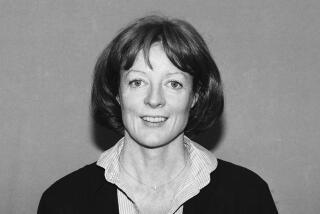Review: Zadie Smith’s ‘NW’ a powerful exploration of lives adrift
NW
A Novel
Zadie Smith
Penguin: 416 pp., $26.95
Zadie Smith’s fourth novel, “NW,” is a return of sorts to the voices and the northwest London landscape of her 2000 debut, “White Teeth.” Like that book, it is exuberant, lush with language, concerned with the relationship of people to their city, with framing not just the lives of characters but also an entire social milieu. And yet, it is more than that, a real sign of how Smith has developed and grown.
“White Teeth,” after all, was the work of a young writer — Smith was 24 when it was published — and it was marked by a young writer’s excess, a young writer’s lack of control. In the decade since, she has done her share of growing up in public, producing a self-conscious homage to E.M. Forster, “On Beauty” (which I admired but also found oddly bloodless) and producing a series of very smart critical essays, gathered in the 2009 collection “Changing My Mind,” that originally appeared in publications such as the New Yorker and the New York Review of Books.
“NW” suggests that she has found a way to balance these considerations — the experiential and the literary or, more accurately, the outer and the inner life. It is a terrific novel: deeply ambitious, an attempt to use literature as a kind of excavation, while at the same time remaining intensely readable, intensely human, a portrait of the way we live.
Built around four contemporaries — Leah, Felix, Natalie and Nathan — who intersect and break apart like ions, the book is an inquiry into many things: consciousness, mortality, community, isolation but, perhaps most important, how identity becomes a creation of the stories we tell about ourselves. “People were not people,” Smith writes, “but merely an effect of language. You could conjure them up and kill them in a sentence.”
Smith makes such an intention explicit from the outset, opening “NW” with an extended stream-of-consciousness section, “Visitation,” which hints at the influence of Virginia Woolf or James Joyce. The story of Leah, a thirtysomething community activist who studied philosophy because (shades of Socrates, or Cicero) “[p]hilosophy is learning how to die,” the sequence highlights a subtle dislocation, since it is not dying that is Leah’s problem but, rather, learning how to live.
“I am eighteen in my mind,” she thinks, “I am eighteen and if I do nothing if I stand still nothing will change I will be eighteen always. For always. Time will never stop. I’ll never die.”
This is a key point, not just for Leah but for everyone, all adrift in the present, unmoored from the future and the past. In part, Smith indicates, that has to do with history; her characters are in the most fundamental sense uprooted, raised in marginal neighborhoods, from immigrant families, their attention directed from the earliest age at moving beyond. But even more, it has to do with something bigger, something about the culture, the way that, in an era of self-absorption, the transition from childhood to adulthood no longer seems as clearly demarcated as it once did.
For Leah, this is both existential condition (witness her desire to remain 18 forever as a way of not forestalling but denying death) and social reality: childless, relatively uncommitted despite being married, she drifts through her life like a spirit or a wraith.
“This house makes her feel like a child,” Smith writes of her, describing a visit to her best friend, Natalie, a lawyer married to a banker and the mother of two young kids. “Cake ingredients and fancy rugs and throw cushions and upholstered chairs in chosen fabrics. Not a futon in sight. Overnight everyone has grown up. While she was becoming, everyone grew up and became.”
Here, we see the crux of “NW,” the central issue that recurs and recombines throughout the book’s five sections, one each for the four main characters, with a return to Leah in the end. The question is authenticity, which Smith frames as a construct, as if not only can we not know other people but in the most fundamental sense, we don’t know ourselves.
This is the reason for the book’s five sections, in which each character expresses his or her own perspective, and we see things from more than one point of view. Nowhere is this more powerful (and moving) than in regard to Leah and Natalie, who both love and misunderstand each other in the way that only close friends can.
Natalie appears to have it all, but the truth is far more complicated, as we understand once Smith opens up her inner life. From the beginning, she has felt indistinct, as if without a personality — “the defeating sense that her own shadow was identical to all the rest, and to the house next door, and the house next to that.”
To Natalie, who as a teen changed her name from Keisha, this is all a matter of identity, a condition Smith emphasizes by referring to her always by her full name: Natalie Blake. The idea is to remind us that adulthood is a part she’s playing, but the deeper resonance has to do with authenticity. Personality, Natalie understands, is elusive, a question of surfaces, of what we own, what we consume, rather than who we are. The inner life is defined by the outer, by the food we eat, the phones we use, even the ideals we espouse.
Smith illustrates the point in a withering brunch scene involving Natalie, her husband and another couple, where the pieties come fast and heavy, framed by pragmatics and family life. “They were all agreed that war should not be happening,” she writes. “They were against war. … Only the private realm existed now. Work and home. Marriage and children. … Sexual perversity was also old-fashioned: it smacked of an earlier time. It was messy, embarrassing, impractical in this economy.”
Later, Natalie encounters Nathan, a school friend turned neighborhood druggie. He and his friends “dressed as kids,” and she “dressed as a successful lawyer in her early thirties.” The phrasing says it all; they are, every one of them, in costume, “the ‘local vibrancy’ to which the estate agents referred.”
Were Smith less interested in language, this could be the stuff of easy irony, of literature masked as social commentary. But the power of the novel is that she continually digs beneath these surfaces, exposing not hypocrisy so much as the emptiness that all her characters feel.
There is a plot here, a loose one that begins when Leah gets scammed by a local crack addict and winds its way to a tragic confluence in which all the main characters (to greater or lesser extent) are involved. That, however, is the least part of the novel: a concession to some need for resolution, which (paradoxically) “NW” doesn’t need.
And yet, if it’s a flaw, it doesn’t seem like much of one. “Only connect,” Forster wrote in “Howards End” (the book that inspired “On Beauty”), but at the heart of the modernist project is the recognition that connection is fleeting, if not impossible — even, or especially, with ourselves.
This is the territory Smith’s novel traces: an inner landscape that we all know because it is ours also: intractable, transient, by turns defining and elusive, as “[w]e wait for an experience large or brutal enough to disturb it or break it open completely, but this moment never arrives.”
More to Read
Sign up for our Book Club newsletter
Get the latest news, events and more from the Los Angeles Times Book Club, and help us get L.A. reading and talking.
You may occasionally receive promotional content from the Los Angeles Times.







